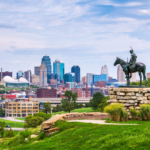From Kansas City to St. Louis, MCE fights to ensure everyone in Missouri has access to clean, healthy air to breathe regardless of their race, income, or where they live.
Air pollution is the largest environmental risk factor for mortality in the United States. MCE advocates for the adoption of policies at the local, state, and federal level to ensure everyone’s health is protected by pollutants in the air that can cause cardiovascular disease, respiratory disease, and cancer.
This work takes the form in proposing new policies to transition faster towards renewable, clean energy sources and away from burning fossil fuels, educating communities about the harms of air pollution, and monitoring permit applications from air polluters and challenging permits with public comments and/or litigation when necessary.
We are committed to protecting access to clean air for every community in Missouri, and we rely on your voice — from small river towns to our biggest cities — to make our work possible.
Climate Change
Climate change in Missouri is affecting our natural resources, our health, and our livelihoods. In Missouri, we are experiencing increased flooding, agricultural pests, and more extreme weather events. An increase in high heat days (temperatures over 100 degrees Fahrenheit) means more visits to the hospital and complications with asthma and other respiratory illnesses.
Many of the species native to Missouri, such as our oak-hickory forests, are threatened by changing temperatures. Furthermore, Missouri generates its energy primarily by burning coal.
Transitioning to renewable forms of energy contributes to a healthier environment and clean jobs for Missourians. MCE is working to protect these natural resources and promote sustainable environmental practices, such as conservation of public lands and responsible agriculture. Learn more by following our program areas.
Learn more about the effects climate change will have on Missouri in the report from the EPA below.
Environmental Racism and Clean Air
St. Louis and Kansas City
There are zip codes in Missouri where the rates of asthma and other respiratory illnesses are much higher than their surrounding communities. In particular, the following reports have identified communities of color in Kansas City and St. Louis that have experienced decades of poor air quality among other environmental hazards. We continuously advocate for policy and practical solutions to addressing these inequities, and we ask for your support in helping us solve these problems.


Clean Air in Rural Missouri
Agriculture is a major contributor to air pollution in our state. Missouri has over 500 Class 1 (large) CAFOs, as visible on our interactive map. Communities near CAFOs often report bad odors from these operations, which can diminish overall quality of life and property values.
The invisible threats in the air near CAFOs, damage air quality and cause health concerns. A recent study shows that of the nearly 16,000 deaths that occur annually in the United States as a result of food-related fine particulate matter, 80% of those are attributable to animal-based foods. Another study showed that the average ammonia concentrations in areas downwind of hog farms were up to 3 times higher than other areas within the same watershed.
With this in mind, MCE is advocating to increase the amount of Missouri Department of Natural Resources’ monitors that are located near these facilities. We are also working with communities near these operations to develop citizen science projects to monitor their air and provide data to policy makers and regulators.
Community-Based Air Monitoring in Missouri
Mining and Clean Air
Mining can have many impacts on air quality and public health, which is why MCE has developed a position on mining in our state.
MCE has also developed the following fact sheets about different types of mining that is common in Missouri.





